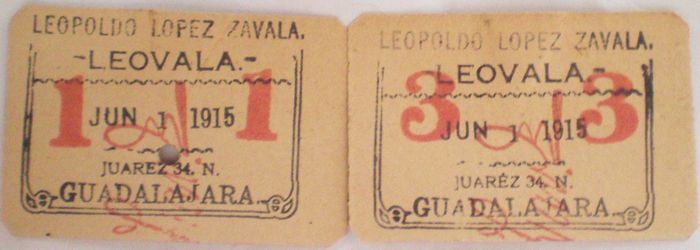Private issues (Guadalajara)
In October 1914 it was reported that some small businesses, because of the lack of small coins, had issued fichas with which to make change. As these could only be used in the same establishment, it seemed that the government would take steps to stop the practiceEl Reformador, Tomo I, Núm. 64, 15 October 1914. However, in June 1915 a newspaper could report that it had received complaints about the paper money issued by cantinas, shops and even hawkers in the market. Although people had done this to overcome the shortage of small change, the practice was illegal and the public were not obliged to accept such paper or cartonesEl Presente, 6 June 1915.
M. Ascencio Morales
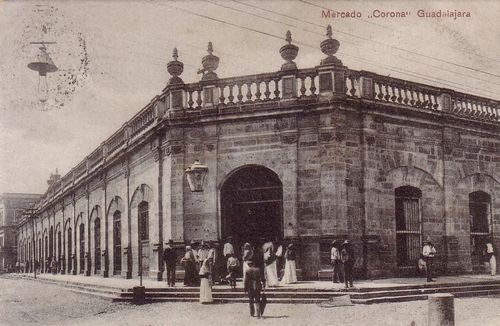
The Mercado Corona is located in the centre of Guadalajara, one block from the Municipal Palace and bounded by the calles Hidalgo, Santa Monica, Zaragoza and Independencia. Its construction began in 1888 by order of Governor Ramón Corona, who was assassinated before the inauguration of the market on 15 September 1891, which is why the city council decided to name it Mercado Corona. The market was in the neoclassical style and had a well-lit dome with Italian windows that let in sunlight that was reflected in a polychromatic way on the central fountain surrounded by flower stalls.
On 15 November 1910, a rocket fired from the Plaza de Armas shattered a window of the market and started a large fire that almost completely destroyed the market. The incident required the need to rebuild the market. However it suffered two more fires in 1919 and 1929, so it was constantly modified.
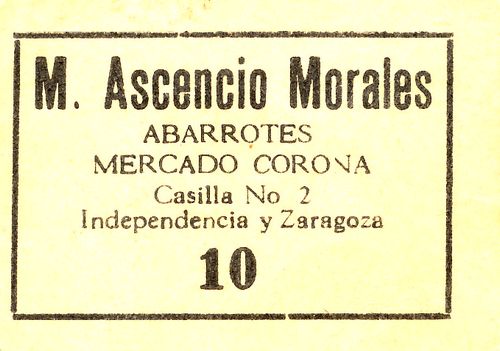 M2521 10c M. Ascencio Morales
M2521 10c M. Ascencio Morales
M. Ascencio Morales ran a booth selling groceries on the corner of calles Independencia and Zaragoza.
"Salón Azteca"
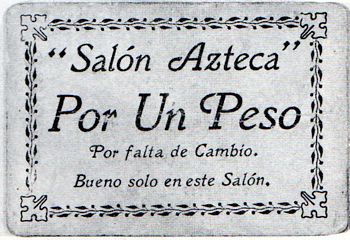
 M2523 $1 Salón Azteca
M2523 $1 Salón Azteca
| series | from | to | total number |
total value |
||
| $1 | A | includes number 119 |
This establishment was run by Agustín Robles. The $1 note specifically states that it is for the lack of change and (on the reverse) that it is payable in infalsificables.
Teodoro Campos Kunhardt y Assoc.
A 50c note[image needed].
Carlos Teodoro Campos Kunhardt was born on 3 November 1881, in Guadalajara, to Miguel Campos Henríquez and Amalia Kunhardt Urrea.
He was a commission agent. On 25 May 1916 he announced that his casa commercial, at calle López Cotilla and calle Maestranza, would that day sell corn to the working classes at 50c a litre. More that five thousand people turned up to take advantage of his offerEl Informador, Año XLIX, Tomo CLXXXVII. Núm. 17,285. 22 May 1966. Then, on 19 October 1917 when a group of businessmen and individuals met to address the lack of corn and threat of hunger by forming a Junta Proveedora de Cereales, Teodoro was appointed Secretario of the organisationEl Informador, Año I, Tomo I. Núm. 15, 20 October 1917.
In the 1930s he owned the hacienda of Quesería, in the neighbouring state of Colima. He died in Guadalajara on 7 January 1936, at the age of 54.
Tienda de Antonio Bayardo
A brown cartón for 10c[image needed].
Compañía Hidroeléctrica e Irrigadora del Chapala, S. A.
From 1892 the production of electricity in Guadalajara was dominated by businessmen of Spanish origin and by Barcelonnettes whose main investments had been in the clothing trade and in the textile industry. It was natural their interest in generating energy for their factories and in electrifying the trams that led to their workers. For a time, another protagonist in Guadalajara was Enrique Schöndube, who obtained around 1897 a concession on the Santiago River, immediate to Guadalajara and that at various points offered the possibility of taking advantage of its waters in electricity generation. Schöndube formed the Empresa de Luz y Fuerza Eléctrica de Las Juntas and in 1902 he would have made a great deal by obtaining 190,000 pesos from the Compañía Industrial de Guadalajara, behind which were Barcelona investors, for the facilities of Las Juntas and the concession for the use of water.
However, in 1903 the Banco Central Mexicano established in Mexico City the Electra company, bought the Compañía de Tranvías de Guadalajara (from the local businessman Francisco Martínez Negrete Alba), then bought the Compañía de Luz Eléctrica de Guadalajara (whose main investor was José María Bermejillo, Spanish and brother-in-law of Martínez Negrete), and took over the electrical department of the Compañía Industrial de Guadalajara in 1907,changing its name and becoming the Compañía Hidroeléctrica e Irrigadora de Chapala S. A. around 1909. Of the total of its shares, 78% corresponded to the Banco Central Mexicano, about 5% were owned by Fernando Pimentel y Fagoaga and the rest was divided among other businessmen close to the same circle.
The company was constituted on 13 July 1909 as a joint stock company, with a capital of $14,000,000, and subscribed by prominent capitalists of Mexico City and Guadalajara, such as Manuel Cuesta Gallardo, landowner and politician from Jalisco; Enrique Tron, merchant and representative of the Banco de Londres y México; Fernando Pimentel y Fagoaga, banker and representative of the Banco Central Mexicano; Diego Moreno, landowner, owner of the haciendas of Guaracha (Michoacán), los Naranjos (Colima) and the hacienda of Buenavista (Jalisco); and the businessmen Jesús Salcido y Avilés and Hugo Scherer junior. Emilio Pinzón and Porfirio Díaz hijo were also shareholders. Cuesta Gallardo, one of the most important shareholders of this company, contributed the concessions that the Porfirista government had granted him to take advantage of waters, demarcate lands and promote irrigation and draining works at Lake Chapala, which he managed to accumulate thanks to the good relations he maintained with Porfirio Díaz. The company developed a power plant at El Salto de Juanacatlán 30 kilometres south of town.
In 1910, the Compañía Hidroeléctrica e Irrigadora de Chapala had taken control of the four large hydroelectric plants in the Guadalajara area, on the Santiago River, which had been built in the previous years by Bermejillo, Schöndube and others: El Salto, Las Juntas, Puente Grande and La Experiencia, which together produced 35,000 horsepower annually. With this production, around 20,000 horsepower was supplied to the lighting and tram services of Guadalajara, as well as to many of the industries of that city, in several of which the same shareholders had interests. In this way, there were 15,000 horsepower that it was necessary to offer, which easily explains the interest in Aguascalientes, Zacatecas and San Luis Potosí, where according to a national newspaper the company had already signed contracts to distribute energy in January 1910.
The company increased its capital by absorbing the Nueva Compañía de Tranvías, Luz y Fuerza de Guadalajara, also known as "La Electra". This had been formed in 1905 when the local electricity company and several horsecar operators combined. Thus the company had a monopoly on these public services.

A streetcar and trailer about to turn from calle de Hidalgo onto avenida Chapultepec about 1910
This company had a shareholders' meeting and a board of directors that met in Mexico City, where it had its official domicile. Its president and representative was Fernando Pimentel y Fagoaga, while the manager and deputy manager were the French Emilio and Eugenio Pinzón.
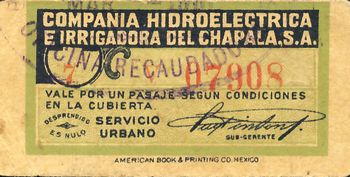 M2514 Compañía Hidroeléctrica e Irrigadora de Chapala
M2514 Compañía Hidroeléctrica e Irrigadora de Chapala
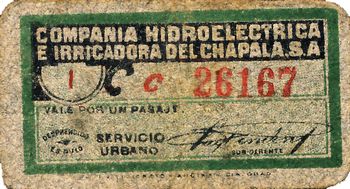 M2515 Compañía Hidroeléctrica e Irrigadora de Chapala
M2515 Compañía Hidroeléctrica e Irrigadora de Chapala
These are coupons for a single fare, without a denomination, and sold in strips of 20, numbered 1 to 20, with the facsimile signature is of Eugenio Pinzón, the sub-gerente.
|
On 5 October 1917 Eugenio was part of a group of businessmen who founded the newspaper, El Informador. Emilio and Eugenio alternated the post of manager, so by December 1917 Eugenio was manager of the company as well as president of the “Círculo Francés de Guadalajara”El Informador, 20 December 1917. |
 |
The first example was printed by the American Book & Printing Company in Mexico City whilst the second, with a serial(?) letter C, was produced by Anciro & Cía.
Though these were fare tickets, DelgadoRicardo Delgado, Las Monedas Jaliscienses durante la Epoca Revolucionaria, Guadalajara, 1938 writes that at the end of 1915 the public in Guadalajara and the neighbouring towns began to use these as small change, with each coupon representing five centavos.
In December 1915 it was said that the company was considering withdrawing its bonos because of their poor state. The company was the winner because it did not exchange or make good any bono that had deterioratedBoletín Militar, Tomo III, Núm. 333, 1 December 1915. Again in February 1916 it was reported that the company would recall its bonos which would make the lack of change even worseBoletín Militar, Tomo V, Núm. 391, 8 February 1916 but the next day the managers wrote to say that because of the effect on the public in agreement with the competent authority they would not be recalling their planillas para pasajesBoletín Militar, Tomo V, Núm. 392, 9 February 1916.
The Drogueria Alemana (German Drugstore)
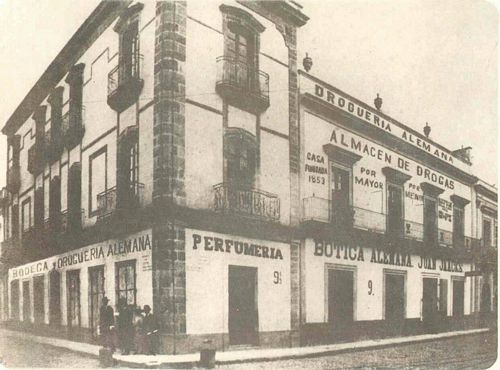
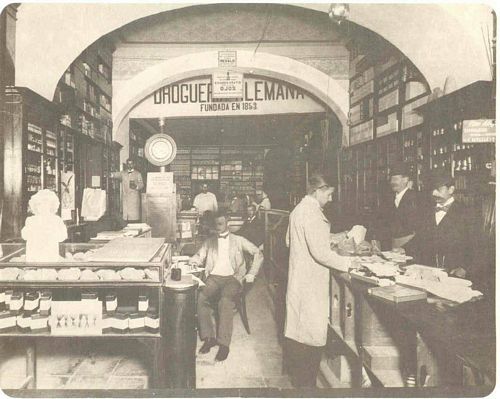
The Drogueria Alemana was run by Carlos Ibarra. On 19 June 1915 he ordered the following $2,000 in cartones, modelo 5266, from Juan Kaiser for a total cost of $97.75.
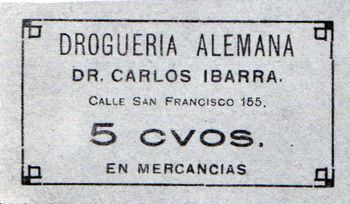 M2505 5c Drogueria Alemana
M2505 5c Drogueria Alemana
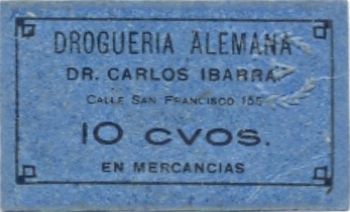
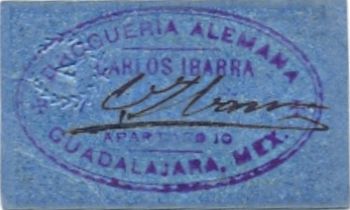 M2506 10c Drogueria Alemana
M2506 10c Drogueria Alemana
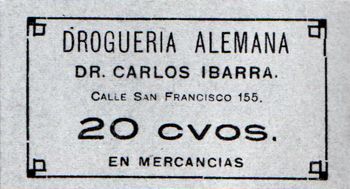 M2507 20c Drogueria Alemana
M2507 20c Drogueria Alemana
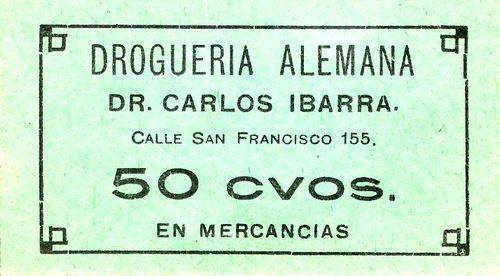 M2508 50c Drogueria Alemana
M2508 50c Drogueria Alemana
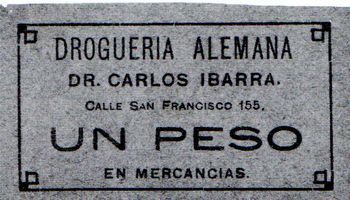 M2509 $1 Drogueria Alemana
M2509 $1 Drogueria Alemana
| total number |
total value |
||
| 5c | 4,000 | $ 200.00 | pink cartón |
| 10c | 4,000 | 400.00 | deep blue cartón |
| 20c | 2,000 | 400.00 | Nile green cartón |
| 50c | 1,000 | 500.00 | green cartón |
| $1 | 500 | 500.00 | yellow cartón |
| 11,500 | $2,000.00 |
In April 1916 an American stationed in Guadalajara told the following tale, of an event that was replicated throughout Mexico.
“The German Drug Store, (probably the largest drug establishment in the city) just opposite the Consulate, on San Francisco Street, closed its doors about a week ago, on account of the following: A customer offered in payment of a purchase a bill which the proprietor refused to accept. The … customer reported the matter to the Presidente Municipal, who fined the druggist five hundred pesos for having committed the offense. When the druggist offered in payment of said fine exactly the kind of paper money which he had refused to accept from the said customer, the said Presidente Municipal did then and there decline to accept such money – which so disgusted the druggist that he at once closed his place of business! The proprietor of the German Drug Store is a Mexican and fearing to fare yet worse from the operation of the edictCarranza threatens establishments closing up or suspending operations, Querétaro, 31 March 1916, he is just now reopening his store"Will B. Davis, Experiences and Observations of an American Consular Office during the recent Mexican revolutions, 1920.
"El Fenix"
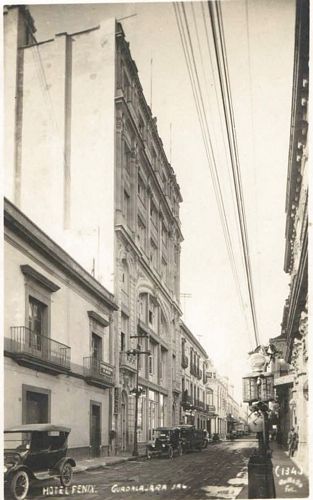

At the beginning of the 20th century there was a demand for glass bottles from the tequila distilleries so the Ramírez and Urzúa brothers, merchants from the Altos de Jalisco, established the first factory in front of the jardín de Analco. Later, they liquidated their businesses and invested the proceeds in a hotel and a pharmacy. The five-storey Hotel Fénix, on avenida Ramón Corona, designed by architect Guillermo de Alba, was one of the first skyscrapers in the Mexican Republic. It opened its doors on 12 July 1912.
During WW1 the Ramírez and Urzúa company was put on the United States’ “Enemy Trading List” as being Germanophile, but the owners managed to persuade the American Embassy in Mexico City to remove them from the listEl Informador, 27 April 1918. It was still advertising as La Ferreteria “Fenix” in April 1920El Informador, 3 April 1920.
The Drogueria y Ferreteria "El Fenix” issued 10c and 20c notes dated 11 May 1915.
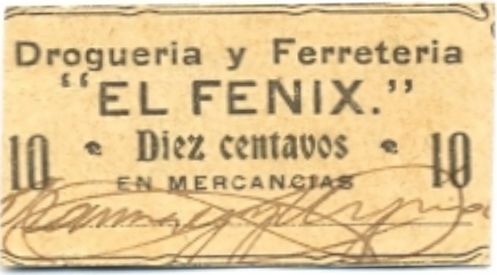 M Unlisted 10c Drogueria y Ferreteria "El Fenix”
M Unlisted 10c Drogueria y Ferreteria "El Fenix”
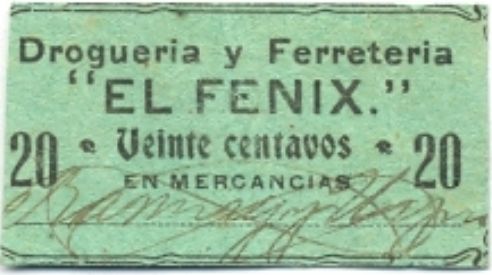 M Unlisted 20c Drogueria y Ferreteria "El Fenix”
M Unlisted 20c Drogueria y Ferreteria "El Fenix”
These carry the name of the owners, Ramírez y Urzúa.
Hotel Francés
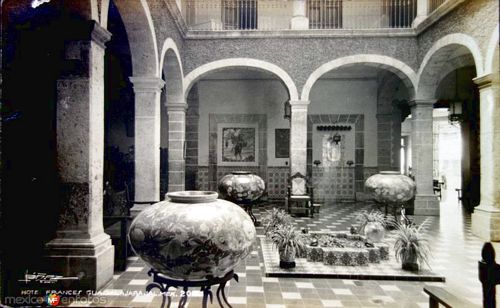
Interior, Hotel Francés
The Hotel Francés is the oldest lodging establishment in Guadalajara, having started in 1610 as the Mesón de San José, a short-term shelter for traders. It has gone through many incarnations through the years.
The cantina of the Hotel Francés issued a 5c note, with the name of Enrique Villa.
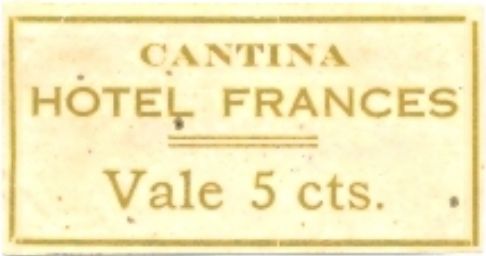
 M Unlisted 5c Hotel Francés
M Unlisted 5c Hotel Francés
| Enrique Villa |
La Fraternal
La Fraternal was a cantina on the corner of Avenida Colón and TequsquiteJalisco Libre, 29 September 1906, run by R. Z. Morales.
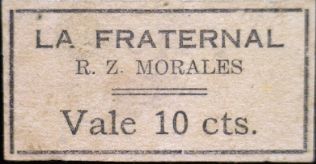
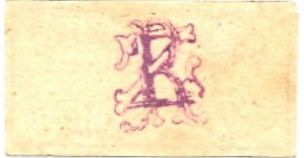 M Unlisted 10c La Fraternal
M Unlisted 10c La Fraternal
A 10c note, placed here because of the similarities in design.
La Imperial
A 5c note.
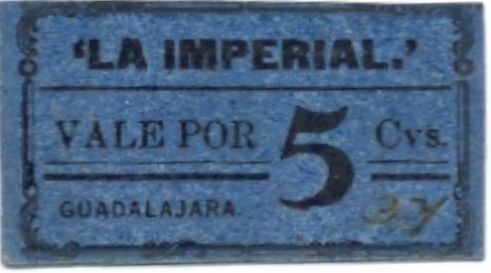
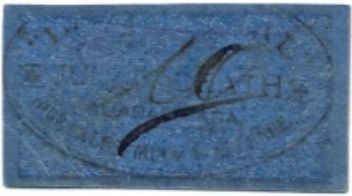 M unlisted 5c La Imperial
M unlisted 5c La Imperial
Restaurante “Valdez”
A 10c note with the name of Francisco Valdez

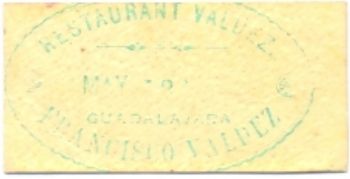 M Unlisted 10c Restaurant "Valdez"
M Unlisted 10c Restaurant "Valdez"
Cantina y Restaurant "Faust"
This restarant in the avenida Colón, owned by M. Caire, has a $5 note[image needed] printed by the nearby Imprenta y Libreria Font y Velasco. The Caires were part of the French community.
Cantina “La Fuente”
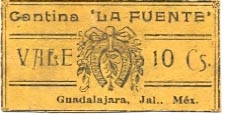
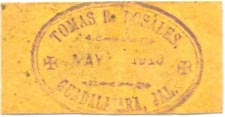 M Unlisted 10c Cantina "La Fuente"
M Unlisted 10c Cantina "La Fuente"
A 10c note dated May 1915 with the stamp of Tomás R. Rosales. Rosales had two outlets, in Mexico City and in Guadalajara, with the exclusive agency for tequila of Aurelio López from the fábrica of San José del Refugio, Amatitlán.
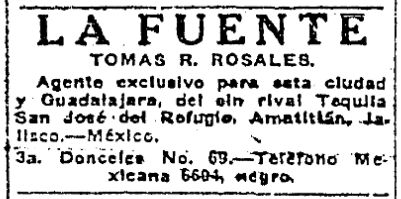
By August 1919 he had lost the agency.

This La Fuente is a different one to the current well-known cantina (with the bicycle) which was opened by Florencio López in 1921.
Cantina “La Metralla”
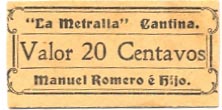
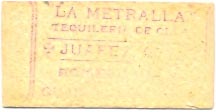 M Unlisted 20c Cantina "La Metralla"
M Unlisted 20c Cantina "La Metralla"
A cantina called “the shrapnel” probably dates from the Revolution. A 20c note with the names of Manuel Romero é hijo
Círculo Recreativo "Excelsior"
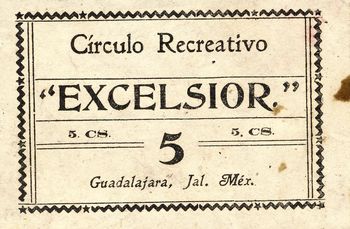 M2511 5c Círculo Recreativo "Excelsior"
M2511 5c Círculo Recreativo "Excelsior"
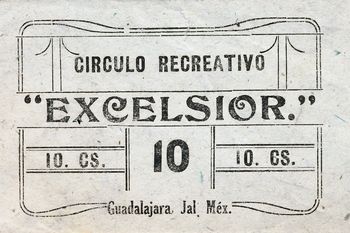 M2512 10c Círculo Recreativo "Excelsior"
M2512 10c Círculo Recreativo "Excelsior"
We know of 5c and 10c notes dated 21 and 22 August 1915.
Empresa de Kioskos
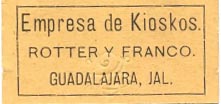
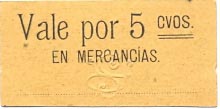 M Unlisted 5c Rotter y Franco
M Unlisted 5c Rotter y Franco
A 5c note with the name of Rotter y Franco.
Depósito de Carbón y Lena
This was run by Salvador Martínez Frías.
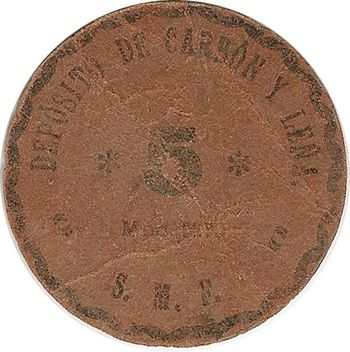 M2501 5c Depósito de Carbón y Lena
M2501 5c Depósito de Carbón y Lena

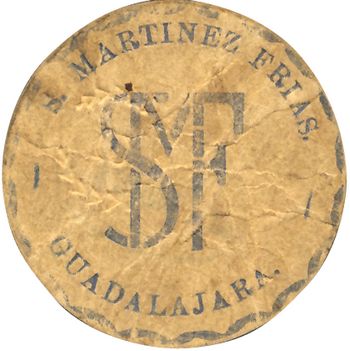 M2502 10c Depósito de Carbón y Lena
M2502 10c Depósito de Carbón y Lena
| Date | modelo | Value | Number issued |
Total | Comment |
| 24 April 1915 | 5235 | 5c | 250 | 2,000 | round cartón |
| 10c | 750 | ||||
| 50c | 1,000 | round cartón: two types | |||
| second issue: no details known |
Leopoldo López Zavala
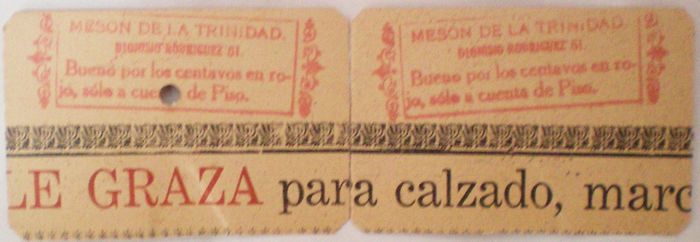
On 19 May 1915 Leopoldo López Zavala, owner of two bars, asked the Presidente Municipal whether he could issue boletos of one and three centavos for his customers to use, attaching samples for consideration.. He was refused but told he could issue chequesAMGuad, Hacienda 1915, exp. 11.
Celso Vergara
On 22 November 1915 a José M. Silva wrote to J. E. González, the Subsecretario interino, that he had $45.50 in cheques issued by Celso Vergara. He had presented them to Vergara who refused to redeem them as the time limit had expired. Then he presented them to the Tesorería Municipal which said that they no longer had funds from Vergara. So he was asking the Governor to order the Tesorería Municipal to exchange them. González passed the message on to the Presidente Municipal who replied, on 24 December, that none of his offices had information on cheques issued by VergaraAMGuad, Hacienda 1915, exp. 145.

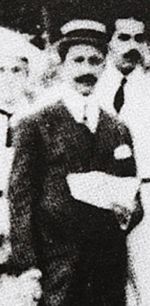 Eugenio Pinzón was from the French community in Guadalajara, so when the tram company went on strike in 1914 they demanded that Pinzón be expelled from the country.
Eugenio Pinzón was from the French community in Guadalajara, so when the tram company went on strike in 1914 they demanded that Pinzón be expelled from the country.